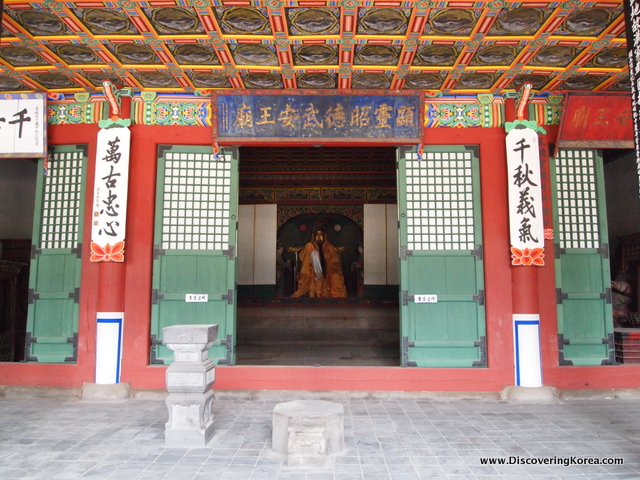Seoul’s Dongdaemun-gu district is one of my favorite parts of the city to explore on foot. Bearing the informal name of the great gate that once marked old Seoul’s eastern boundary, Dongdaemun’s many winding alleys provide all kinds of surprises for an afternoon walkabout.

The neighborhoods just north of the Cheonggyecheon Stream and Jungang Public Market is where you can find an interesting mix of industrial supply shops, textile vendors and what’s left of an old open-air flea market.
Among these relatively modern arrivals to the neighborhood is a truly ancient one. Seoul Dongmyo Shrine (서울동묘), which used to be called Dongwangmyo, is designated Treasure #142.
Literally translated as “Eastern Shrine,” Seoul Dongmyo was built in 1599 to honor Guan Yu, a Chinese military commander from the 3rd century. Guan Yu remains one of China’s best known historical figures, and fictionalized descriptions of his military exploits formed much of the historical novel, Romance of the Three Kingdoms.

Guan Yu’s life is relevant to Korea, because he is said to have helped the Joseon kingdom and Ming China repel Japanese forces from the Korean Peninsula after seven years of General Hideyoshi’s invasions from 1592 through 1598.
At the end of the 16th century, Korea had defeated Japan, but the kingdom was exhausted. However, it was said that the spirit of Guan Yu had repeatedly appeared in battle to help Korea defeat the invading Japanese.
Despite the fact that worshipping the general as a deity was inconsistent with Korea’s Neo-Confucianist ideology, Ming Dynasty officials insisted that Joseon build and maintain shrines to Guan Yu as part of the two countries’ bilateral relationship.

So over the course of three years, three shrines were constructed – one to the east, one to the west and one in the north in the city. Among them, only the eastern shrine, Seoul Dongmyo, remains.
Today, the 9,300-square-meter shrine is surrounded by a stately stone wall. Including the front gate, the complex’s seven buildings form two courtyards, with a large peony garden forming most of one.
Mature trees and leaf cover virtually the entire shrine, which creates a pleasant, cool resting spot during hot summer days. While small flocks of pigeons peck at the ground, older gentlemen recline on benches and children safely play within its walls.
The main building’s architecture is unusual among most Korean buildings from the Joseon era in that it boasts a double-roof where the roofs of the front terrace and main shrine combine.

Furthermore, the extensive use of brick on three sides lends the shrine an almost garrison-like appearance, a feel quite different from the refined elegance of most Joseon-era buildings.
When I visited, the main building was off limits to visitors, but through the gate I could see some of the impressive calligraphic plaques that decorate the interior.
At the back, even the wooden statue of Guan Yu was visible. Inside the special chamber, he is attended by four painted statues. Apparently, the red-faced figure represents the general in his earthly form, while the yellow-faced one represents his spirit.
Rather than a must-see destination in and of itself, Seoul Dongmyo is one of those unexpected treats that come with an off-the-beaten-path exploration of South Korea’s capital.
For Your Information..
| Open: | Closed holidays |
| Admission Price: | Free |
| Address: | Jongno-gu Sungin-dong 238-2 |
| Directions: | Dongmyo Station (#127/#636) on Lines 1 & 6, Exit 3 |
| Phone: | 02-731-0535 |
| Website: |
About Matt Kelley
Matt Kelly is native of the US Pacific Northwest and is half-Korean by ethnicity. He lived in Korea for five years and has written hundreds of travel guides for Wallpaper, TimeOut, the Boston Globe and Seoul Magazine and was a host for several different variety shows on Korean radio and television.
